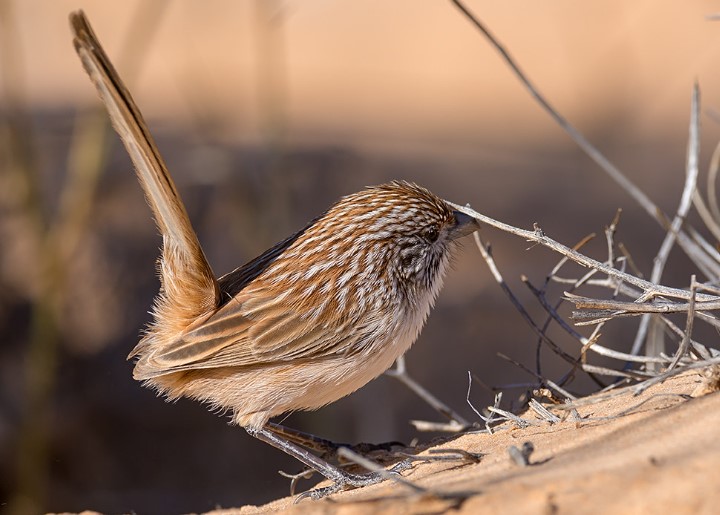Family: The Regent honeyeater (Anthochaera phrygia) belongs to the family Meliphagidae.
Habitat: The decline of this dazzling black-and-yellow honeyeater has been alarmingly subtle. Once, it occurred commonly in congregations of 60–100 in flowering eucalypts around southeastern Australia, 30 or 40 years ago. Sadly, today it is found only singly, in pairs or small groups of no more than 10, and then infrequently. Over the past 30 years, the extent of the Regent Honeyeater’s habitat hasn’t changed greatly, as well-shaded eucalypt woodlands and open forests flanking the Great Dividing Range remain the same.
The Regent Honeyeater is an irruptive and partly migratory bird, moving north in autumn and winter, returning south in spring, and congregating anywhere there is a blooming flower. In districts where they have been few or absent for many years, they will suddenly appear in numbers.
Manna and honeydew are gleaned from leaves, and insects are captured by probing crevices in bark or on aerial sallies. They frequently ring metallic chinkings calls in contact, often from perches with bobbing and stretching movements of the heads, or in flight. The Regent Honeyeaters nest in isolated pairs, although sometimes they breed in loose colonies. The female apparently incubates unaided, but the male stands sentry high in a nearby tree for much of the time and later helps in the feeding of the young.

Diet: Their main source of food and energy is nectar, which comes from box eucalypts and ironbark eucalypts, banksias, mistletoes, insects, manna, lerps, and fruit. They feed aggressively on the outer foliage—chasing or being chased—and fly swiftly from tree to tree, their wings often clattering. The bird also feeds on cultivated and native fruit.
Identification: Both sexes are similar; the male is larger. The head and upper and lower neck are black, with pink-buff, bare, warty skin around the eyes. The back, scapulars, and rump are black and scalloped cream-yellow. Wings are black, and feathers are edged patchily broad yellow. The tail is black, and the outer feathers are bright yellow. Lower breast and belly are cream scalloped black; undertail is cream white. The eyes are red-brown. The bill is black. The feet are dusky gray. The immature (as adults) but duller, blacker, and browner; bill buff to base.
Vocalization: Regent Honeyeater’s call is a metallic, bell-like chink. The song is a rolling, oriole-like clink-clank or tink-tink-tink, from perch or in song-flight.
Nesting and Breeding: Nesting and breeding occur mainly in August and January. Nest in a thick-walled cup of bark strips bound with cobwebs. The nest is lined with fine dry grass and bark shreds, about 65 x 50 mm inside, supported by a thick vertical fork, an upright forked branch or horizontal branch of a tree or bush, or knots in mistletoe clumps. Nests are made 1–19 meters above ground.
Eggs: Regent honeyeaters usually lay two, sometimes three eggs; red-buff, darker towards the larger end, with small purple-red and violet-grey markings, usually forming a zone at the larger end; oval to tapered-oval, about 24 x 18 mm. Incubation is responsible for females.
Distribution: Regent Honeyeater is found in Eucalypt woodland and open forest on both flanks of the Great Dividing Range, north to about Brisbane, Queensland, and southwest to Bendigo, Vic., with outliers in the Mt Lofty Ranges and Kangaroo Island, South Australia. Nomadic and irruptive; declining. Once, the Regent honeyeater was very common in eastern Australia, adjacent to a great diving range. Also found in Brisbane, it has now vanished from SA to Western Victoria.

Important Bird Areas: Regent honeyeaters are observed in important areas (Traprock in Queensland), (Warby-Chiltern Box-Ironbark Region in Victoria), and (in New South Wales, they are found in Tuggerah, Brisbane Water, Richmond Woodlands, Bundarra-Barraba, Mudgee-Wollar, Capertee Valley, Lake Macquarie, Greater Blue Mountains, Hunter Valley, and Hastings Macleay).
Taxonomy: Famous naturalist George Shaw first described the Regent Honeyeater in 1794. Further, DNA analysis indicates a connection to Anthochaera, a wattlebird genus. There was an earlier lineage of wattlebirds that diverged from the little and western ones.
Status: This flagship species is critically endangered.
Close Species: It closely resembles Wattlebirds.
Races: There are no races.
Alternative Names: It is also known as Embroidered Haneyeater, Warty-Faced Haneyeater, Flying Coachman, and Turkeybird.
Size: The Regent Honeyeater measures about 200–220 mm long.







